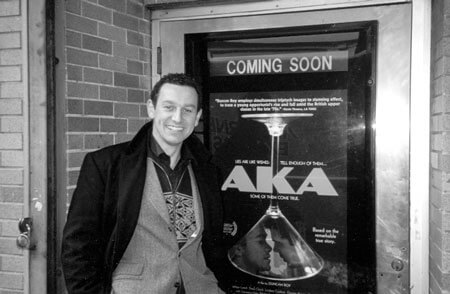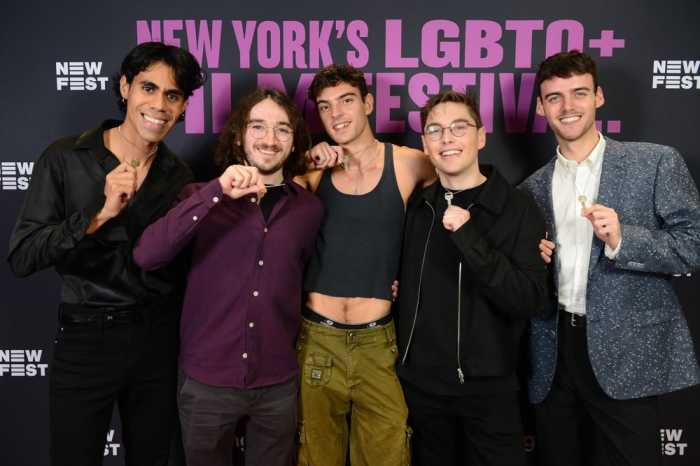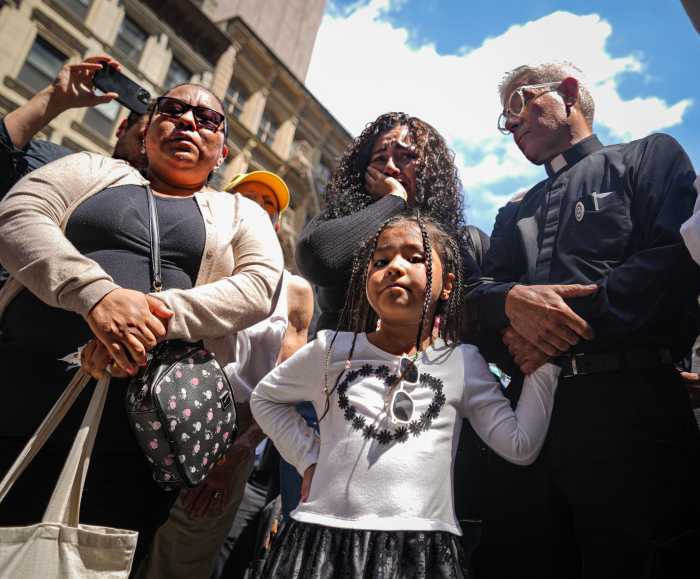Duncan Roy’s latest film “AKA” garnered raves on the queer film circuit
Filmmaker… and memoirist, too?
Duncan Roy in New York this week.
“Do you want to do this here?” Duncan Roy asks while surveying the lobby of the Union Square W Hotel. He scans the room like a Terminator, sizing it up quickly yet precisely. Before we’re done with tea, he’ll touch on not only the W’s creepy Sheraton vibe, but also his giant bathroomed suite at the Mercer and his membership at SoHo Club. He’ll also coin the term “boutique hotel queen.” Roy mentions palling around with visual artist Sam Taylor Wood in the U.K. and expresses an almost “Calendar Girls” rigor about English country life in almost the same breath. But he hasn’t sat yet and, in his defense, we are shouting to hear one another against a horn track that’s unbelievably boisterous for 2 p.m. in the afternoon. He seems happy to direct and then just smiles and plops down on the couch. Layers of tweed, argyle, and a pair of Oxfords read: very Englishman in New York. Roy is okay with that, living between England and New York for the last six years. “I’m not very good at L.A.,” Roy allowed. “I’m not very good at being disingenuous.” In fact, a lot of Roy seems to reside in the way he responds to the Prince Charles question. He starts talking about Liberace. With a poker face, he’ll see your British scandal, then raise you.
“I really want to do the Liberace story,” Roy enthused, “It interests me for one reason. Liberace said at the very end that he wasn’t gay. It was up to him. If he felt like saying he wasn’t gay, then who are we to make sure he knows what he is. If you suck cock every single day, who’s to say you’re not what you say you are? We’re very good about proscribing what people are, and that makes me nervous.” He sits back as if he’s trying to evaluate how this is going and then rushes forward again. “In terms of Liberace, people want to keep the myth going. I think what we need to do is define some of the mythology around the stars, the celebrities, like Tom Cruise. Whoever decided that Tom was never going to be revealed to be gay or to sleep with men or to stick with that line? John Travolta, or any of the people that we know are sleeping with guys, they understand branding—the notion of branding. These guys are straight super heroes, that’s what they are.”
All this and we haven’t even gotten to his painterly triptych AKA, a U.K. melodrama that unfolds across three adjacent panels. But Roy’s camera isn’t Warhol’s split-screened, split personality “Chelsea Girls” variety. “We did it only on one camera and shot things again and again and again,” Roy said about the shoot. After which he had 60 hours of footage and something akin to a year in the editing atelier stitching it all up. “It was like knitting,” Roy laughed, “If you got the stitches wrong earlier on in the piece, you had to undo everything to make it right. It was about getting enough material to feed into the notion of three screens.” The triptych does a remarkably effective job of telling the story of a late 70s English lad who leapfrogs out of his abusive home and into a privileged world of money, title, cocaine, and paintings. “I was asked to make it,” Roy explained of the project’s origins. “It’s based on a true story that had gone down as English folklore as one of those stories that people knew about, but never really new the truth of it. But when you make a fictional film about that, you add to the mythology rather than clarify it. I thought when I was putting the idea together that I was making a memoir. It was about the subtle shifts and differences in the way we view one particular moment.”
Hold up. Did Roy just say memoir? The director left home at 16 to work for Lady Rendlesham’s Yves Saint Lauren shop in London. It’s here that his bio starts to mirror the plot of his latest film. Between the ages of 17 to 22, Roy posed as Lady Rendlesham’s son Anthony, cutting a swath on fraudulent credit cards that landed him in Wormwood Scrubs prison. Still, I think I’ve misheard. I knew the film was based on an actual event, but Roy has to spell it out for me. “It happened to me. The story is my story. The story of AKA is autobiographical.” Imagine if John Guarre hadn’t penned “Six Degrees of Separation,” but rather stepped aside and let the black gay con artist Paul tell his own story. “I tried to tell the story as honestly and as openly as I could because I didn’t want other people to misinterpret my intention which is why Channel Four asked me to do it originally. I think they found it a bit too controversial. Regarding the English class system, it’s quite a controversial little story. English posh people loathe it. They find it very difficult to deal with.”
The same cannot be said of the U.S., where rising above one’s class is practically part of the national fabric. But things don’t get any less slippery when Roy details the film’s life on the gay and lesbian festival circuit, where it garnered numerous awards. “I’ve always been very well served by the gay and lesbian community,” he began, adding, “I’m an outsider.” When pressed on this point, he replied, “Regardless of whether I make films where men fuck each other or not, I’m kind of making films where we challenge ideas of how films should be made. The gay and lesbian film festival circuit is the perfect medium for that.” Still, when asked to compare New York to L.A. or Miami’s festival fare, Roy cannot resist being prickly. “New York’s isn’t terribly well run or well funded,” he deadpanned. “It was a bit sloppy considering there are so many gay people here. There’s a lot of moaning about money and I don’t see the people that are running it are putting much in. I mustn’t slag it off, though. I mustn’t be horrible. But obviously L.A. is attached to the massive film industry and gets a lot of money.”
But what about Roy? “Do I personally identify as gay or lesbian?” he asked, laughing as he repeats the question. “I don’t know how I’d describe myself nowadays, but there certainly was a time when I’d describe myself as gay. I’ve had sex with women and there are people who would say that I was gay. It’s up to me really how I describe myself. As I’ve grown older, gay, straight, bisexual. They don’t necessarily apply. I don’t think of myself as being cunning. That’s actually a political decision about what I want to do or where I want to put my cock and where I don’t want to put my cock. Ultimately, I don’t subscribe to the idea that you’re one thing or the other.”
He’s not resting any easier on the hot young filmmaker label either. Halfway through a three-picture deal that came about largely through AKA’s calling card festival clout, Roy just wrapped a picture with Elizabeth Hurley and Jeremy Sisto about serial killers. Roy calls it his “Hollywood movie” and can barely conceal rolling his eyes when he speaks of it. “It’s just for money, really,” he said, then elaborated. “It’s like having children. My first three I’m so proud of. And even though I love my fourth child, I love it so much that I can’t wait for it to leave home. I love you, but I’m going to let you leave here. You can get people to do things for nothing if there’s a really good script that’s been really well developed. We’ll be associated with AKA for the rest of our careers and yet it wasn’t about money. If that makes me a pinko communist, fine, but it also makes me someone interested in art and AKA is an art film made for the love of art.”
Watch for Roy to return to that tradition as he begins shooting his take on Oscar Wilde’s “The Picture of Dorian Gray.” He’ll only say it involves AIDS and Princess Diana. No word on whether or not there’s a candelabra-festooned piano in the attic. Stand by, Larry King.


































